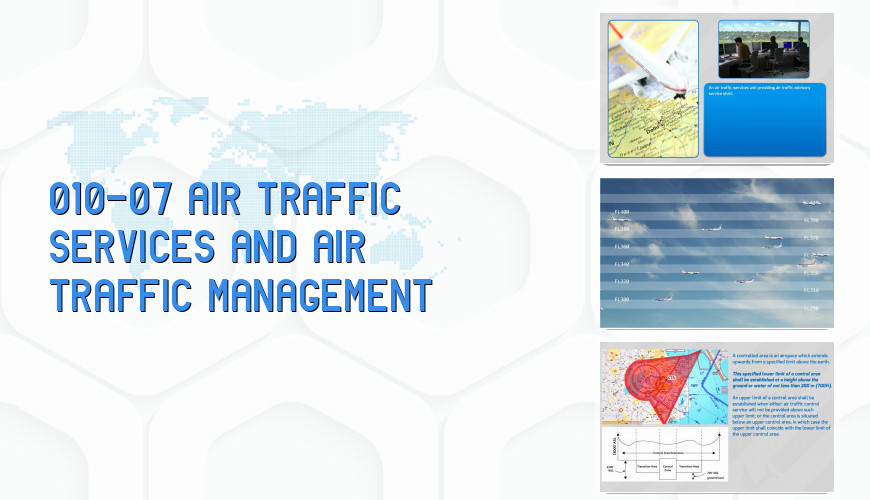
Course Information
The main objective of Air Traffic Services is to rule & order the aviation traffic properly to: Prevent collisions between aircraft, Terrain avoidance, Expedite and maintain an orderly flow of air traffic, Provide advice and information useful for the safe and efficient conduct of flights, Notify appropriate organizations if they need search and rescue aid, and assist such organizations as required. Courses are constantly monitored and updated when major changes in authority documentation are released.
Content of the Course
| Slide | 105 | Duration | 1:26:12 | Exam | No |
|---|
- COURSE START
- AIR TRAFFIC SERVICES / DEFINITIONS
- Air Traffic Services In General
- AIR TRAFFIC SERVICES’ OBJECTIVES
- AIRSPACE
- Flight Information Region (Fir)
- Upper Information Region (Uir)
- Control Area (Cta)
- Control Zone
- Airspace Classification
- KINDS OF AIR TRAFFIC SERVICES
- ATC CLEARANCES IN GENERAL
- Issuance Of Atc Clearance
- Instructions Included In Clearances Relating To Levels
- Read-Back Of Clearances And Safety-Related Information
- UNIVERSAL TIME (UTC)
- FLIGHT INFORMATION SERVICE (FIS)
- Operational Flight Information Service (Ofis) Broadcasts
- ATIS / VOICE ATIS
- Data Link Atis
- Meteorological Information Via Volmet Broadcasts And D-Volmet Service
- ALERTING SERVICE
- Emergency Situation
- Emergency Message Classification
- Notification Of Distress / Urgency By Visual Signals
- Emergency Frequency And Codes
- Phases Of Alerting Service
- Content Of Emergency Information
- REQUIRED NAVIGATION PERFORMANCE TYPES AND REQUIREMENTS
- Performance Based Navigation
- ATS ROUTE
- Route Designator General
- Ats Route Designator
- Ats And Area Navigation Route
- Supplementary Prefix And Suffix
- Minimum Flight Altitudes
- AIR TRAFFIC MANAGEMENT
- GENERAL PROVISIONS FOR AIR TRAFFIC SERVICES
- Horizontal Speed Control Instructions
- Vertical Speed Control Instructions
- Change From Ifr To Vfr Flight
- WAKE TURBULENCE
- ALTIMETER SETTING PROCEDURES / DETERMINATION OF THE TRANSITION LEVEL
- POSITION REPORTING
- Content Of Position Reports
- Automatic Dependent Surveillance (Ads) Reports
- REPORTING OF OPERATIONAL AND METEOROLOGICAL INFORMATION
- STANDARD SEPARATION METHODS AND MINIMA
- Separation Of Aircraft Holding In Flight
- Minimum Separation Between Departing Aircraft
- Separation Of Departing Aircraft From Arriving Aircraft
- Time Based Wake Turbulence Longitudinal Separation Minima For Arriving
- Distance Based Wake Turbulence Longitudinal Separation Minima
- Separation In The Vicinity Of Airports
- Separation For Visual Traffic
- PROCEDURES FOR AERODROME CONTROL SERVICE-AERODROME CONTROL TOWERS
- SELECTION OF RUNWAY IN USE
- Information To Aircraft By Aerodrome Control Towers
- Essential Information On Aerodrome Conditions
- Suspension Of Vfr Operations
- Procedures For Low Visibility Operations
- ATS SURVEILLANCE SYSTEM IN GENERAL
- Surveillance Radars (Psr, Ssr, Ads-B, Mlat)
- Traffic Situation Display
- Ssr Code Management
- Verification Of Level Information
- Radar Vectoring
- AIR TRAFFIC ADVISORY SERVICE
- PROCEDURES RELATED TO EMERGENCIES, COMMUNICATION FAILURE AND CONTINGENCIES / EMERGENCY PROCEDURES
- Emergency Descent
- Communication Failure
- Interception Of Civil Aircraft
- Unlawful Interference
- COURSE END

